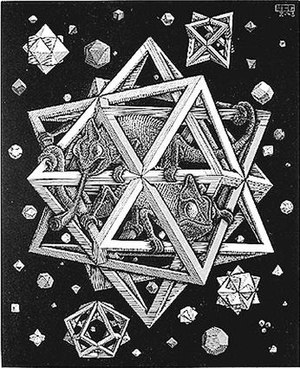Stars (M. C. Escher)
| Stars | |
|---|---|
 |
|
| Artist | M. C. Escher |
| Year | 1948 |
| Type | wood engraving |
| Dimensions | 32 cm × 26 cm (13 in × 10 in) |
Stars is a wood engraving print created by the Dutch artist M. C. Escher in 1948, depicting two chameleons in a polyhedral cage floating through space.
Although the compound of three octahedra used for the central cage in Stars had been studied before in mathematics, it was most likely invented independently for this image by Escher without reference to those studies. Escher used similar compound polyhedral forms in several other works, including Crystal (1947), Study for Stars (1948), Double Planetoid (1949), and Waterfall (1961).
The design for Stars was likely influenced by Escher's own interest in both geometry and astronomy, by a long history of using geometric forms to model the heavens, and by a drawing style used by Leonardo da Vinci. Commentators have interpreted the cage's compound shape as a reference to double and triple stars in astronomy, or to twinned crystals in crystallography. The image contrasts the celestial order of its polyhedral shapes with the more chaotic forms of biology.
Prints of Stars belong to the permanent collections of major museums including the Rijksmuseum, the National Gallery of Art, and the National Gallery of Canada.
Stars is a wood engraving print; that is, it was produced by carving the artwork into the end grain of a block of wood (unlike a woodcut which uses the side grain), and then using this block to print the image. It was created by Escher in October 1948. Although most published copies of Stars are monochromatic, with white artwork against a black background, the copy in the National Gallery of Canada is tinted in different shades of turquoise, yellow, green, and pale pink.
...
Wikipedia
